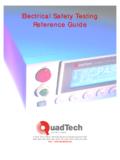Transcription of Topic 1 Improving Power Supply Efficiency – The Global ...
1 Topic 1 Improving Power Supply Efficiency The Global perspective 1-1 Improving Power Supply Efficiency The Global perspective Bob Mammano, texas instruments ABSTRACT There should be no question that we have seen increasing importance placed on Efficiency as a goal in Power Supply design. This Topic addresses the incentives for this emphasis, both market driven and regulatory, by describing some effective voluntary programs and reviewing the status of developing governmental requirements. A review of contributors to Power losses will be given together with design techniques and suggestions for minimizing their impact with new Power Supply architectures. I. INTRODUCTION Energy Efficiency has always been a consideration in the design of Power supplies. After all, losses in the conversion of Power from a primary source into that necessary to meet specific system load requirements serve no value to the system and, in fact, impose an added cost to both the system and its user.
2 It was largely the quest for improved Efficiency that drove the transition from linear regulators and 50/60 Hz Power transformers to high-frequency switching technologies. However, that quest remains unabated today with perhaps even greater urgency, as we see ever-increasing world-wide demands for electrical Power coupled with diminishing availability of low-cost fossil fuels to generate that Power . Some of the statistics that have been generated to illustrate the need for improved electrical Efficiency include the following: Today there are over 10 Billion electronic Power supplies in use world wide, more than Billion just in the United States. The typical Efficiency of these Power supplies lies within the range of 30% to 60% today. Energy consumed internally in these Power supplies amounts to some 110 to 150 Billion kWhrs/year, representing a loss of ~3 to 4% of the total electricity usage in the Increasing the average Efficiency of these Power supplies by just 10% would: o Reduce lost Power by 30 Billion kWhrs/year, which in turn would o Save approximately $3 Billion per year o An amount equal to the cost of building 4 to 6 new generating plants Savings attributable to the Energy Star program in 2005 have: o Saved more than $ Billion in consumer energy bills o Saved enough electricity to Power Million homes o Reduced generating emissions equivalent to removing Million cars And, of course, the United States is not alone in coping with these numbers.
3 In fact, the US may well be following the leads of many other countries in efforts to improve energy utilization, but the point is that today, Improving electrical Efficiency has become a world-wide issue. Fig. 1. is a collection of just some of the logos for governmental agencies established to encourage energy Efficiency within their countries. The methods used in these endeavors range from education, through developing market incentives, to mandated regulations. Access to many of these agency s web sites can be made through the Power Sources Manufacturers Association (PSMA) via this link: 1-2 European Code of Conduct EPA Energy Star Nordic Swan CA Energy Commission German Blue Angel China Energy Conservation Project Korea Energy Management Corp Japan Environment Association European Union Eco Label Fig.
4 1. Logos representing a sampling of government agencies promoting improved energy Efficiency throughout the world. II. ACTIVE ENERGY-SAVING PROGRAMS With many countries independently developing standards and programs for Improving Efficiency of Power supplies, one would expect that there would develop a wide range of requirements and methods for implementation. Actually, much has been accomplished toward the harmonization of both test procedures and specifications through world-wide discussions and collaboration, although there are differences in plans for making these requirements mandatory. Most countries have initially begun their efforts for higher Efficiency with a carrot approach of education to develop consumer awareness leading to a demand for products earning a higher Efficiency rating, and showcasing that accomplishment by the use of the applicable agency logo on the product s packaging.
5 The Energy Star label has been particularly successful in this endeavor within the US, and the resultant gains have been impressive. An excellent web site for exploring these activities can be found at: This idea of a product marking approach to achieving continuous improvement through market incentives has been developed further by the Australian Greenhouse Office through a program designed for external, modular Power supplies that establishes a scale of numerical grades for meeting a range of Efficiency goals. The Efficiency grade level earned for a particular product, indicated by a Roman numeral of I through VI, can then be incorporated into the product s label as shown in Fig. 2. (Grade I means no Efficiency specification, Grade III is equivalent to Energy Star Tier 1 requirements, Grades to VI are reserved for future improvements in performance).
6 1-3 Fig. 2. The Efficiency level of an external Power Supply can be evaluated by a prospective user through a Roman numeral marking on the name plate. The levels are established by a measure of Average Efficiency , which is defined as the arithmetic average of Efficiency measurements taken at 25%, 50%, 75%, and 100% of rated full Power of the unit, and with a visible, quantitative indicator, users can compare Efficiency on a par with other performance and cost parameters in making buy decisions. Many other countries are expected to join with Australia in applying this idea. Another marketing incentive developed through Ecos Consulting, with support from the Energy Star group within the Environmental Protection Agency (EPA) and the California Energy Commission (CEC), has been named 80 Plus and is specifically directed toward computer Power supplies.
7 This program has established a specific Efficiency requirement of 80% at each of three load levels 20%, 50%, and 100% of full load plus an input Power factor of at least The incentive for meeting this requirement is a cash rebate to the manufacturer for each computer with a compliant Power Supply , of $ for desktops and $ for servers, sold into specific geographical regions. The funding for these incentives has been negotiated to come from the particular Power utility serving those regions. And again, Power supplies achieving this standard may wear a unique logo on their label, as shown in Fig. 3. III. MANDITORY STANDARDS Voluntary programs of those mentioned above, as well as many others, have done much to raise general awareness while driving performance improvements in many specific applications.
8 But since there is almost always some cost for Improving Efficiency , eventually we reach a position where the carrot of marketing pull must be aided with the stick of mandated requirements. These, of course, usually take the form of government specifications for equipment to meet specific limits of minimum energy Efficiency . This is beginning to happen in China and Australia, with the United States not far behind with the 2005 Energy Policy Act including a provision tasking the Department of Energy to develop a mandatory US standard for Power supplies. The California Energy Commission has acted faster by requiring that all external Power supplies sold in that state must meet specified Efficiency limits by July of 2006. Qualifying units can use thelogo and earn $5 incentive.
9 Fig. 3. The 80 Plus program provides a cash incentive, as well as a marking indicator, for meeting a specific Efficiency standard. Of course, any organized attempt to impact the Power Supply industry broadly immediately runs into the reality of the breadth of this industry. Questions as, What types of Power supplies?, What applications?, What Power ratings?, What operating conditions?, and What test procedures? must be answered before even getting to the question of what the limits will be. But much work has transpired in addressing these issues. 1-4 Test specifications have been developed and harmonized between the various agencies for many applications.
10 And the general philosophy has been to start with specific applications that have the potential for the greatest gain in overall energy savings, and then expand the program into areas that have the next-highest potential for energy reductions. In Power supplies, the first targeted application for mandatory standards has been external, or modular supplies, both ac/dc and ac/ac inverters with Power ratings from zero to 250 Watts. The standard developed by Energy Star with the participation of many other agencies - subdivides into two operating conditions: No Load (or Standby), where the criteria is in terms of input current (since the output current is zero), and Active Load, where Efficiency is determined as the average of measurements at four values of load 25%, 50%, 75%, and 100% of rated (nameplate) load.

















